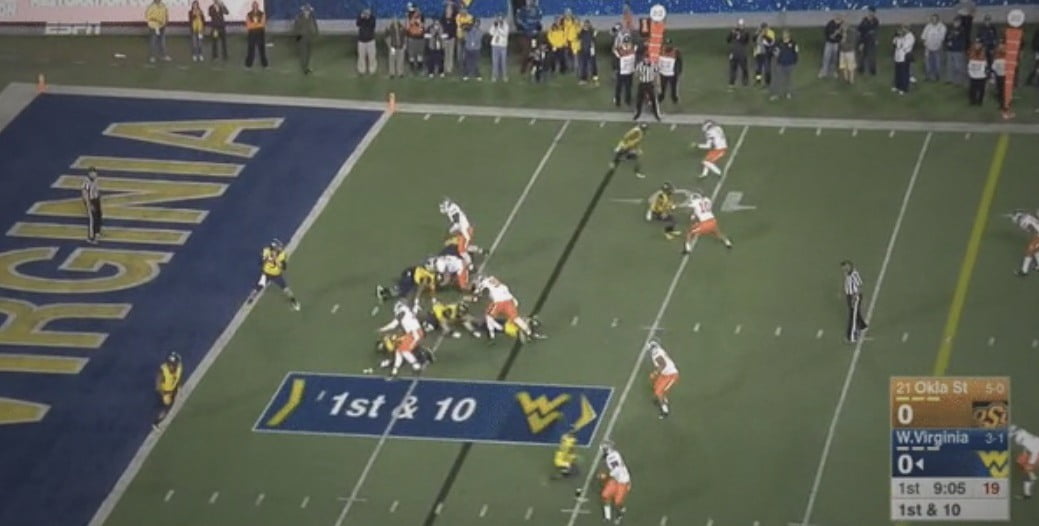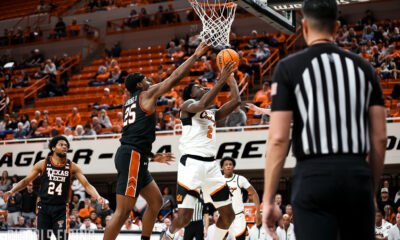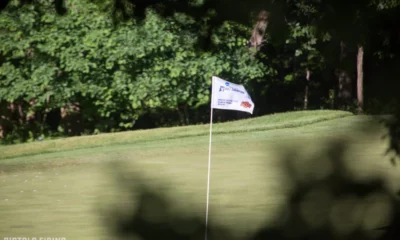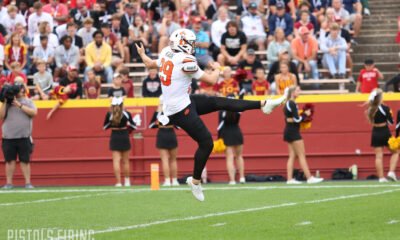Football
Film Study: How Oklahoma State’s Linebackers Help Its Lineman Get Sacks

What WVU was doing
WVU is in a shotgun formation with 4 WRs out wide and the RB on the QB’s left. The tackles are in a pass protect stance. The two guards and center are in a three-point run block stance.
From the moment the ball is snapped we can already see something unique about this play. All five linemen drop back a couple steps and then fall to the ground. This is what’s known as a ‘cut’ block. The cut block is completely legal (although it has a reputation of being dirty), so long as the offensive lineman doesn’t perform the cut block on a defensive player that’s already engaged with another offensive player and as long as it’s done within the tackle box (pocket).
Essentially, the cut block is a way to take a defensive player out of the play. If things go accordingly, the defender is cut and falls to the ground, giving the QB or RB more time/room to make the play. On this play, WVU was hoping to cut the defensive line and create a wide open window for the QB to get the ball to one of the WRs on the left side.
The WRs to that side are running hi-lo slants, where both receivers are doing slants, but one (the inside WR) runs his more shallow and the outside WR runs his a bit deeper.
What OSU was doing
The Pokes are in the Base 4-3 defense. The DEs are lined up on the outside shoulders of the offensive tackles, making them 5-techniques. I can’t tell for certain, but Motekiai Maile appears to be lined up across from the LG, while Vincent Taylor is lined up directly across from the center (0-technique).
Seth Jacobs is bumped out a bit covering the inside WR on the right side. Notice how Chad Whitener and Jordan Burton shift to their left when the WVU RB goes in motion. With the motion happening, the RB now becomes Burton’s responsibility. Whitener is playing zone coverage in the hook zone, which is basically the five to ten-yard area in the middle of the field.
The CBs are playing about three yards off the WRs, an indicator that they will be playing tight man-to-man coverage. You might recall the same aggressive style being played by the CBs on first down in last week’s defensive film study.
Lastly, you can see both safeties are playing about 11 yards off the ball. With it being first-and-10 and WVU showing the tendency to run and throw the quick pass, the safeties are making sure to keep the first down line in front of them so they can defend against the run or the short pass.

Why this worked for OSU
As I said, the cut block is meant to take certain defenders out of the play. Obviously, this is contingent upon the offensive linemen actually causing the defender to go to the ground because if he is unsuccessful, the d-lineman has a free pass to the backfield.
Here, the LT had absolutely no success in attempting the cut block on this play. Jimmy Bean is easily able to side step the attempt and carry on about his business trying to bring the QB down.
But even though Bean was basically unblocked, the play still had a tiny chance to be successful had it not been for one other player: Seth Jacobs.
Again, WVU is all about utilizing the quick pass—getting the ball into the WR’s hands as quickly as possible and allowing them to make a play. When the ball is snapped, the QB immediately looks left, which tells us he was hoping to hit one of the hi-lo slant routes.
However, Jacobs gives his receiver a solid “bump” when he comes off the ball and knocks him off his routes just enough to be able to still play tight coverage on him. This causes the QB to hesitate because he sees his speedy WR is completely covered. By this time, Bean has already gotten to the QB and drags him down for the easy sack.

-

 Hoops5 days ago
Hoops5 days agoFIU Transfer Arturo Dean Commits to Oklahoma State
-

 Hoops4 days ago
Hoops4 days agoTexas Tech Transfer Robert Jennings Commits to Oklahoma State
-

 Golf5 days ago
Golf5 days agoOSU Freshman Preston Stout Sinks Long Putt to Earn Share of Big 12 Title
-

 Football5 days ago
Football5 days agoAustrailian Punter Hudson Kaak Details Transition to Stillwater, Football






